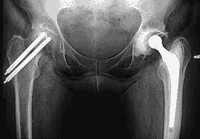Internal fixation inferior to arthroplasty for displaced femoral neck fractures
Swedish study finds high failure rate and inferior function in patients treated with internal fixation.
NEW ORLEANS — Internal fixation resulted in a failure rate of 44% compared to 7% for arthroplasty when used to treat displaced femoral neck fractures in older patients, according to the results of a study presented here.
The prospective, randomized study involved 450 patients aged 70 and older with displaced femoral neck fractures. The patients were treated by 20 orthopedic surgeons at 12 Swedish hospitals from 1995 to 1997. Patients were randomized to be treated with either internal fixation (IF) or primary arthroplasty and were then followed for five years. Within the arthroplasty group, active patients received total arthroplasty, and inactive and older patients received hemiarthroplasty.
Patients with dementia, who were institutionalized or who were nonambulatory were excluded.
In the internal fixation group, failure was defined as avascular necrosis, early redislocation, osteonecrosis or deep infection. In the arthroplasty group, failure was defined as recurrent dislocation, femoral fracture, prosthesis loosening or deep infection.
The results were presented at the American Academy of Orthopaedic Surgeons 70th Annual Meeting.
Short-term IF advantages
“Internal fixation has some advantages in the short term with shorter surgery time and shorter hospital stay,” said Cecilia Rogmark, MD, of Malmö University Hospital, Malmö, Sweden, and affiliated with the University of Lund. “But after two years we found a failure rate of 43% in the IF group compared to only 6% in the arthroplasty group. Almost all of the failed patients [in the IF group] were reoperated upon. Three of the 12 patients in the arthroplasty group [with failed treatment] had revision surgery.”
 --- In this radiograph, the right hip was operated on
with internal fixation, two "hook pins", and the left one with total hip
arthroplasty.
--- In this radiograph, the right hip was operated on
with internal fixation, two "hook pins", and the left one with total hip
arthroplasty.
COURTESY OF CECILIA ROGMARK
Rogmark said that there were few new failures after the first two years yielding a total failure rate of 44% in the IF group and 7% in the arthroplasty group.
In addition to the significantly lower failure rate, “the arthroplasty group had less need of walking aids up to four months and superior walking ability throughout the follow-up period,” Rogmark said.
While patients in the IF group had more pain, inferior function, greater dissatisfaction and a high failure rate, the study found similar mortality rates of about 50% in both groups at the five-year mark.
Arthroplasty recommended
“We recommend that primary arthroplasty be performed on select patients over [age] 70 with displaced femoral neck fractures,” Rogmark said.
The debate over the treatment of displaced femoral neck fractures is not new. Rogmark cited a quote from 1934 in which Kellogg Speed dubbed this type of fracture as “the unsolved fracture” during an oral presentation in the Congress of the American College of Surgeons held in Boston. “In those days, the debate was whether the fracture should be treated by bed rest, plaster of Paris or internal fixation. Later on, arthroplasty became an alternative,” Rogmark said. “The conducted studies compared treatments; however, there has been a tendency to first decide what you prefer, and then make a study,” Rogmark said.
Scandinavian countries have had a long tradition of closed reduction and internal fixation for treating displaced femoral neck fractures. In recent years, randomized trial results have favored primary arthroplasty in the treatment of displaced femoral neck fractures.
For your information:
- Rogmark C, Johnell O, Carlsson A, Sernbo I. Primary arthroplasty vs. internal fixation in displaced femoral neck fractures: a randomized study of 450 patients, 5-year results. #126. Presented at the American Academy of Orthopaedic Surgeons 70th Annual Meeting. Feb. 5-9, 2003. New Orleans.
